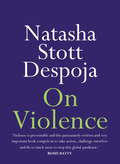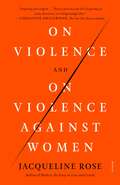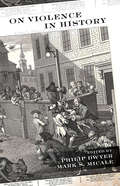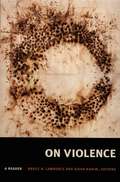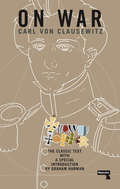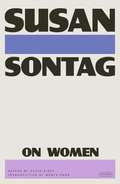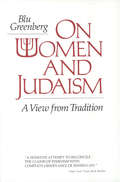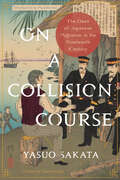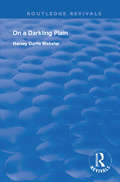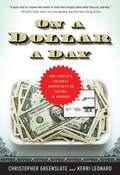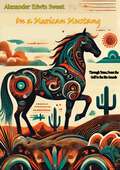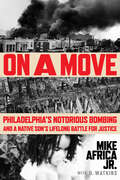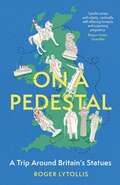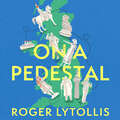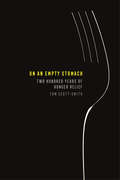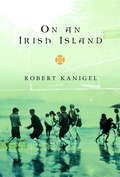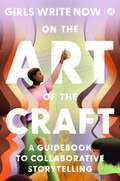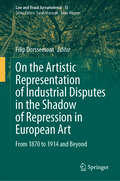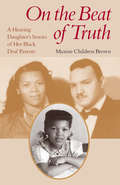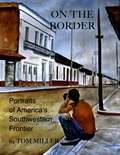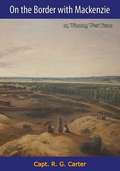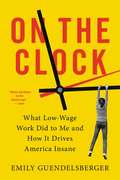- Table View
- List View
On Violence
by Natasha Stott DespojaWhy is violence against women endemic, and how do we stop it?Every two minutes, police are called to a family violence matter. Every week, a woman is killed by a current or former partner.This is Australia's national emergency.Violence against women is preventable. It is not an inevitable part of the human condition. It is time to create a new normal. It is time to stop the slaughter in our suburbs.
On Violence and On Violence Against Women
by Jacqueline RoseA blazingly insightful, provocative study of violence against women from the peerless feminist critic.Why has violence, and especially violence against women, become so much more prominent and visible across the world? To explore this question, Jacqueline Rose tracks the multiple forms of today’s violence – historic and intimate, public and private – as they spread throughout our social fabric, offering a new, provocative account of violence in our time.From trans rights and #MeToo to the sexual harassment of migrant women, from the trial of Oscar Pistorius to domestic violence in lockdown, from the writing of Roxanne Gay to Hisham Mitar and Han Kang, she casts her net wide. What obscene pleasure in violence do so many male leaders of the Western world unleash in their supporters? Is violence always gendered and if so, always in the same way? What is required of the human mind when it grants itself permission to do violence?On Violence and On Violence Against Women is a timely and urgent agitation against injustice, a challenge to radical feminism and a meaningful call to action.
On Violence in History
by Philip Dwyer Mark S. MicaleIs global violence on the decline? Steven Pinker’s highly-publicized argument that human violence across the world has been dramatically abating continues to influence discourse among academics and the general public alike. In this provocative volume, a cast of eminent historians interrogate Pinker’s thesis by exposing the realities of violence throughout human history. In doing so, they reveal the history of human violence to be richer, more thought-provoking, and considerably more complicated than Pinker claims.
On Violence: A Reader
by Bruce B. Lawrence Aisha KarimThis anthology brings together classic perspectives on violence, putting into productive conversation the thought of well-known theorists and activists, including Hannah Arendt, Karl Marx, G. W. F. Hegel, Osama bin Laden, Sigmund Freud, Frantz Fanon, Thomas Hobbes, and Pierre Bourdieu. The volume proceeds from the editors' contention that violence is always historically contingent; it must be contextualized to be understood. They argue that violence is a process rather than a discrete product. It is intrinsic to the human condition, an inescapable fact of life that can be channeled and reckoned with but never completely suppressed. Above all, they seek to illuminate the relationship between action and knowledge about violence, and to examine how one might speak about violence without replicating or perpetuating it. On Violence is divided into five sections. Underscoring the connection between violence and economic world orders, the first section explores the dialectical relationship between domination and subordination. The second section brings together pieces by political actors who spoke about the tension between violence and nonviolence--Gandhi, Hitler, and Malcolm X--and by critics who have commented on that tension. The third grouping examines institutional faces of violence--familial, legal, and religious--while the fourth reflects on state violence. With a focus on issues of representation, the final section includes pieces on the relationship between violence and art, stories, and the media. The editors' introduction to each section highlights the significant theoretical points raised and the interconnections between the essays. Brief introductions to individual selections provide information about the authors and their particular contributions to theories of violence. With selections by: Hannah Arendt, Walter Benjamin, Osama bin Laden, Pierre Bourdieu, Andr Breton, James Cone, Robert M. Cover, Gilles Deleuze, Friedrich Engels, Frantz Fanon, Michel Foucault, Sigmund Freud, Mohandas Gandhi, Ren Girard, Linda Gordon, Antonio Gramsci, Flix Guattari, G. W. F. Hegel, Adolf Hitler, Thomas Hobbes, Bruce B. Lawrence, Elliott Leyton, Catharine MacKinnon, Malcolm X, Dorothy Martin, Karl Marx, Chandra Muzaffar, James C. Scott, Kristine Stiles, Michael Taussig, Leon Trotsky, Simone Weil, Sharon Welch, Raymond Williams
On War (Unabridged Start Publishing Llc Ser.)
by Carl von ClausewitzA new edition of von Clausewitz's classic treatise on military strategy, reinterpreted by Graham Harman through the philosophy of speculative realism.Prussian General Carl von Clausewitz famously wrote that 'War is the continuation of politics by other means'. But what does Clausewitz mean to a world where economic, political and cultural conflicts are increasingly framed as wars?Written after the Napoleonic Wars but left unfinished at the author's death and not published until 1832, On War is one of the most influential and important works on military strategy ever written. This new edition presents this classic text with a new introduction by Graham Harman, who reads Clausewitz's ideas about war, politics and military strategy through the lens of speculative realism.
On Women
by Susan SontagA pithy and brilliant introduction to Susan Sontag’s writing on women, gathering early essays on aging, equality, beauty, sexuality, and fascism Susan Sontag was one of the most formidable, original, and influential thinkers of the last century. “The most interesting ideas are heresies,” she remarked, and indeed, her writing rejects the familiar and refuses party lines.On Women presents seven essays and exchanges, spanning a range of subjects: the challenges and humiliations women face as they age; the relationship between women’s liberation and class struggle; beauty, which Sontag calls “that over-rich brew of so many familiar opposites”; feminism; fascism; and film. Taken together, these pieces—relentlessly curious, historically precise, politically robust, and allergic to easy categorization Sontag’s inimitable mind at work.
On Women and Judaism: A View From Tradition
by Blu GreenbergA classic for more than 20 years, this thought-provoking volume explores the role of Jewish women in the synagogue, in the family, and in the secular world. Greenberg offers ways to change present Jewish practices so that they more readily reflect feminine equality.
On Your Case: A Comprehensive, Compassionate (and Only Slightly Bossy) Legal Guide for Every Stage of a Woman's Life
by Lisa GreenTelevision legal analyst and attorney Lisa Green offers something new: a witty, direct and empowering legal guide for women, filled with accessible information they can employ to understand and respond to common legal issues throughout their lives, from dating, marriage, and kids to jobs, retirement, aging parents, and wills.Lisa Green has an urgent message for women of all ages, especially those who consider themselves fully briefed on nutrition, personal finance, good schools, and great bargains:What about the law?Whether or not you invite it into your life, the law will find you. When it does, will you be ready to respond?In On Your Case, Lisa fills a long-standing gap in women's bookshelves with a thorough, compelling and occasionally hilarious guide to the range of legal issues women can expect to confront throughout their busy lives. Leveraging her professional training as a lawyer and her personal experience as a wife, ex-wife, mother, and daughter, Lisa explains common, even complicated, legal issues in practical, easy to understand terms. Sharing true stories, from jaw-dropping court cases to her own personal challenges, Lisa explains how readers can make the best possible decisions when problems arise. And legal problems will arise, Lisa counsels, so women need to get smart, and get ready.In her warm, yet firm, voice, Lisa guides readers through the potential legal issues around: Relationships: Online dating, pre and postnuptial agreements, engagement and marriage Separation and Divorce: Splitting without anxiety, child custody and support, pet custody disputes Babies, Children and Teens: Pregnancy and adoption, advocating for a special needs child, misbehaving teens Work: Employment and household help Domestic violence Social media Midlife and elder care: Wills, medical decisions and power of attorney Legal Help: Hiring a lawyer, DIYAs Suze Orman demystified personal finance and put women in the driver's seat of their own financial future, Lisa Green now does for the law. With On Your Case, Lisa empowers you by equipping you with the tools you need to take care of yourself, your assets, your family, and your career.
On a Collision Course: The Dawn of Japanese Migration in the Nineteenth Century
by Yasuo SakataIn five meticulously researched essays, Yasuo Sakata examines Japanese migration to the United States from an international and deeply historical perspective. Sakata argues the importance of using resources from both sides of the Pacific and taking a holistic view that incorporates US-Japanese diplomatic relationships, the mass media, the American view of Asian populations, and Japan's self-image as a modern, westernized nation. In his first essay, Sakata provides an overview of resources and warns against their gaps and biases; those that remain may reflect culturally based inaccuracies. In the other essays, Sakata examines Japanese migration through a multifaceted lens, incorporating an understanding of immigration, labor, working conditions, diplomatic relationships, and the effects of war and mass media. He further emphasizes the distinctions between the dekasegi period, the transition period, and the imin period. He also discusses the self-image among Japanese as distinct from the Chinese, more westernized and able to assimilate—a distinction lost on Americans, who tended to lump the Asian groups together, both in treatment and under the law. Japan's Meiji era brought the opening of Japanese ports to Western nations and Japan's eventual overseas expansion. This translated volume of Sakata's well-researched work brings a transnational perspective to this critical chapter of early Japanese American history.
On a Darkling Plain (Routledge Revivals)
by Harvey Curtis WebsterOriginally published in 1947 and presenting the famed poet-novelist against the background of contemporary thought and society, Harvey Curtis Webster shows that Hardy's later works give consistent evidence of hope; that pervasive pessimism was by no means the keynote of Hardy's thought. On a Darkling Plain traces the evolution of Hardy's thought, from faith, through disillusionment, to a cautious belief in the ultimate progress of man.
On a Dollar a Day: One Couple's Unlikely Adventures in Eating in America
by Christopher Greenslate Kerri LeonardWhat happens when two high school teachers get fed up with their soaring grocery bills and decide to try to feed themselves on one dollar each, per day? Authors Kerri Leonard and Christopher Greenslate describe how they did it--and also include sections about eating on a little more than $4 a day, as well as on the actual costs of eating a healthy diet.On a Dollar a Day also includes fascinating facts about the way our food gets to the table and the hidden costs--both personal and financial--along the way: How food companies "short size" packages so that you pay more for less food? Why one tablespoon of salad dressing costs as much as a whole orange? How grocery stores auction off foods past their "sell by" dates? Why processed foods have a higher markup than fresh foods? Why it takes so long for food prices to drop, even after fuel and shipping costs go down? How 36 million Americans have limited food options, even during a national obesity epidemic?
On a Mexican Mustang, Through Texas, From the Gulf to the Rio Grande
by Alexander Edwin Sweet"On a Mexican Mustang, Through Texas, From the Gulf to the Rio Grande" by Alexander Edwin Sweet is a captivating and humorous travelogue that takes readers on a vibrant journey across the vast and diverse landscapes of Texas in the late 19th century. Sweet, an accomplished writer and journalist, along with co-author J. Armoy Knox, offers an engaging and richly detailed account of their adventurous expedition on horseback from the Gulf of Mexico to the Rio Grande.This classic work captures the essence of Texas with its vivid descriptions of the state's varied terrain, from lush coastal regions to arid deserts and bustling towns. Sweet's keen eye for detail and his talent for storytelling bring to life the unique character of each locale they visit, as well as the colorful personalities they encounter along the way. The book is filled with lively anecdotes and humorous observations, making it an entertaining read from start to finish.Throughout their journey, Sweet and Knox provide insightful commentary on the social, economic, and cultural aspects of Texas life during this period. They explore the complexities of Texan identity, the impact of Mexican and Native American influences, and the rugged spirit of the frontier. Their interactions with a diverse array of people, from ranchers and cowboys to farmers and townsfolk, offer a multifaceted view of the state and its inhabitants."On a Mexican Mustang" is more than just a travel narrative; it is a valuable historical document that captures a pivotal time in Texas history. Sweet's humorous and often satirical writing style adds a unique flavor to the narrative, making it a delightful read for anyone interested in the history and culture of Texas.This book is an essential addition to the library of history buffs, travel enthusiasts, and anyone who enjoys a well-told tale of adventure and exploration. Alexander Edwin Sweet's "On a Mexican Mustang, Through Texas, From the Gulf to the Rio Grande" remains a timeless and engaging journey through one of America's most iconic states, offering readers a glimpse into the rich tapestry of Texas life.
On a Move: Philadelphia's Notorious Bombing and a Native Son's Lifelong Battle for Justice
by Mike Africa Jr.The incredible story of MOVE, the revolutionary Black civil liberties group that Philadelphia police bombed in 1985, killing 11 civilians—by one of the few people born into the organization, raised during the bombing's tumultuous aftermath, and entrusted with repairing what was left of his family."As necessary and powerful as it is captivating." – Michael Harriot, New York Times bestselling author of Black AF History"Searing and urgent." – Bakari Sellers, New York Times bestselling author of My Vanishing Country and The MomentBefore police dropped a bomb on a residential neighborhood on May 13, 1985, few people outside Philadelphia were aware that a Black-led civil liberties organization had taken root there. Founded in 1972 by a charismatic ideologue called John Africa, MOVE’s mission was to protect all forms of life from systemic oppression. They drew their ideology from the Black Panther Party and pre-dated animal and environmental rights groups like PETA and Earth First. MOVE emerged in an era when Black Philadelphians suffered under devastating policies brought by the long, doomed war in Vietnam, Mayor Frank Rizzo’s overtly racist police surveillance, and, eventually, President Ronald Reagan's War on Drugs. MOVE members lived together in a collection of West Philadelphia row houses and took the surname Africa out of admiration for the group's founder.But in MOVE's lifestyle, city officials saw threats to their status quo. Their bombing of MOVE homes shocked the nation and made international news. Eleven people were killed, including five children. And the City of Brotherly Love became known as the City That Bombed Itself.Among the children most affected by the bombing was Mike Africa Jr. Born in jail following a police attack on MOVE that led to his parents’ decades-long incarcerations, Mike was six years old and living with his grandmother when MOVE was bombed. In the ensuing years, Mike sought purpose in the ashes left behind. He began learning about the law as a teenager and became adept at speaking and inspiring public support with the help of other MOVE members. In 2018, at age 40, he finally succeeded in getting his parents released from prison.On a Move is one of the most unimaginable stories of injustice and resilience in recent American history. But it is not only one of tragedy. It is about coming-of-age for a young activist, the strong ties of family, and, against all odds, learning how to take indignities on the chin and to work within the very system that created them. At once a harrowing personal account and an impassioned examination of racism and police violence, On a Move testifies to the power of love and hope, in the face of astonishing wrongdoing.
On a Pedestal: A Trip around Britain's Statues
by Roger LytollisThis is a book for people who are interested in statues . . . and for people who aren't. It explores those immortalised in marble and bronze - and what the rest of us think about them.As Roger Lytollis travels Britain he encounters a man at Liverpool's Beatles statue convinced that Rod Stewart was in the Fab Four. In Edinburgh he walks into a row over Greyfriars Bobby's nose and in Glasgow learns why the Duke of Wellington wears a traffic cone on his head. London brings a controversial nude statue and some hard truths about racism.Elsewhere, Roger sees people dancing with Eric Morecambe, finds a statue being the backdrop to a marriage proposal and, everywhere he goes, pigeons. Always pigeons . . .On a Pedestal is the first book to examine public statues around the nation. It looks at their emergence into our culture wars; the trend for portraying musicians, sports stars and comedians rather than monarchs, politicians and generals; the amazing tales of many of those commemorated on our streets.It also features interviews with sculptors, including Sir Antony Gormley, telling the stories behind some of our most popular modern statues.Part history book, part travelogue, On a Pedestal brings statues to life. Informative and entertaining, it's a book that - ultimately - is more about blood than bronze.
On a Pedestal: A Trip around Britain's Statues
by Roger LytollisThis is a book for people who are interested in statues . . . and for people who aren't. It explores those immortalised in marble and bronze - and what the rest of us think about them.As Roger Lytollis travels Britain he encounters a man at Liverpool's Beatles statue convinced that Rod Stewart was in the Fab Four. In Edinburgh he walks into a row over Greyfriars Bobby's nose and in Glasgow learns why the Duke of Wellington wears a traffic cone on his head. London brings a controversial nude statue and some hard truths about racism.Elsewhere, Roger sees people dancing with Eric Morecambe, finds a statue being the backdrop to a marriage proposal and, everywhere he goes, pigeons. Always pigeons . . .On a Pedestal is the first book to examine public statues around the nation. It looks at their emergence into our culture wars; the trend for portraying musicians, sports stars and comedians rather than monarchs, politicians and generals; the amazing tales of many of those commemorated on our streets.It also features interviews with sculptors, including Sir Antony Gormley, telling the stories behind some of our most popular modern statues.Part history book, part travelogue, On a Pedestal brings statues to life. Informative and entertaining, it's a book that - ultimately - is more about blood than bronze.
On a Pedestal: A Trip around Britain's Statues
by Roger LytollisThis is a book for people who are interested in statues . . . and for people who aren't. It explores those immortalised in marble and bronze - and what the rest of us think about them.As Roger Lytollis travels Britain he encounters a man at Liverpool's Beatles statue convinced that Rod Stewart was in the Fab Four. In Edinburgh he walks into a row over Greyfriars Bobby's nose and in Glasgow learns why the Duke of Wellington wears a traffic cone on his head. London brings a controversial nude statue and some hard truths about racism.Elsewhere, Roger sees people dancing with Eric Morecambe, finds a statue being the backdrop to a marriage proposal and, everywhere he goes, pigeons. Always pigeons . . .On a Pedestal is the first book to examine public statues around the nation. It looks at their emergence into our culture wars; the trend for portraying musicians, sports stars and comedians rather than monarchs, politicians and generals; the amazing tales of many of those commemorated on our streets.It also features interviews with sculptors, including Sir Antony Gormley, telling the stories behind some of our most popular modern statues.Part history book, part travelogue, On a Pedestal brings statues to life. Informative and entertaining, it's a book that - ultimately - is more about blood than bronze.
On an Empty Stomach: Two Hundred Years of Hunger Relief
by Tom Scott-SmithOn an Empty Stomach examines the practical techniques humanitarians have used to manage and measure starvation, from Victorian "scientific" soup kitchens to space-age, high-protein foods. Tracing the evolution of these techniques since the start of the nineteenth century, Tom Scott-Smith argues that humanitarianism is not a simple story of progress and improvement, but rather is profoundly shaped by sociopolitical conditions. Aid is often presented as an apolitical and technical project, but the way humanitarians conceive and tackle human needs has always been deeply influenced by culture, politics, and society. These influences extend down to the most detailed mechanisms for measuring malnutrition and providing sustenance.As Scott-Smith shows, over the past century, the humanitarian approach to hunger has redefined food as nutrients and hunger as a medical condition. Aid has become more individualized, medicalized, and rationalized, shaped by modernism in bureaucracy, commerce, and food technology. On an Empty Stomach focuses on the gains and losses that result, examining the complex compromises that arise between efficiency of distribution and quality of care. Scott-Smith concludes that humanitarian groups have developed an approach to the empty stomach that is dependent on compact, commercially produced devices and is often paternalistic and culturally insensitive.
On an Irish Island: The Lost World Of The Great Blasket
by Robert KanigelOn an Irish Island is a love letter to a vanished way of life, in which Robert Kanigel, the highly praised author of The Man Who Knew Infinity and The One Best Way, tells the story of the Great Blasket, a wildly beautiful island off the west coast of Ireland, renowned during the early twentieth century for the rich communal life of its residents and the unadulterated Irish they spoke. With the Irish language vanishing all through the rest of Ireland, the Great Blasket became a magnet for scholars and writers drawn there during the Gaelic renaissance--and the scene for a memorable clash of cultures between modern life and an older, sometimes sweeter world slipping away. Kanigel introduces us to the playwright John Millington Synge, some of whose characters in The Playboy of the Western World, were inspired by his time on the island; Carl Marstrander, a Norwegian linguist who gave his place on Norway's Olympic team for a summer on the Blasket; Marie-Louise Sjoestedt, a Celtic studies scholar fresh from the Sorbonne; and central to the story, George Thomson, a British classicist whose involvement with the island and its people we follow from his first visit as a twenty-year-old to the end of his life. On the island, they met a colorful coterie of men and women with whom they formed lifelong and life-changing friendships. There's Tomás O'Crohan, a stoic fisherman, one of the few islanders who could read and write Irish, who tutored many of the incomers in the language's formidable intricacies and became the Blasket's first published writer; Maurice O'Sullivan, a good-natured prankster and teller of stories, whose memoir, Twenty Years A-Growing, became an Irish classic; and Peig Sayers, whose endless repertoire of earthy tales left listeners spellbound. As we get to know these men and women, we become immersed in the vivid culture of the islanders, their hard lives of fishing and farming matched by their love of singing, dancing, and talk. Yet, sadly, we watch them leave the island, the village becoming uninhabited by 1953. The story of the Great Blasket is one of struggle--between the call of modernity and the tug of Ireland's ancient ways, between the promise of emigration and the peculiar warmth of island life amid its physical isolation. But ultimately it is a tribute to the strength and beauty of a people who, tucked away from the rest of civilization, kept alive a nation's past, and to the newcomers and islanders alike who brought the island's remarkable story to the larger world.
On the Alternative Punishment to the Death Penalty in China
by Gui HuangThis book presents a study of alternative penalties to the death penalty in China, aiming to promote theoretical exploration of death penalty reform in China as well as long-term penal reform. Currently, China is endeavouring to control the use of the death penalty and is gradually moving towards its abolition. The factors influencing the choice of the punishment option to replace the death penalty are complex and varied and include the traditional punishment culture, penalty concepts, the political system, the punishment system, public opinion and human rights, etc. Given the differences between China and developed Western democratic states, when we examine these influencing factors, we cannot ignore the culture of the punishment and the special political and legislation system in China. In this light, this work examined and analysed the factors that influence the choice of punishment option to replace the death penalty in this special political system with its clearly Chinese characteristics. Criminal policy and public opinion are two significant and typical factors involving obvious political considerations in China. The former normally reflects and carries out the will of the Government as expressed to the national management; the latter responds to the majority of citizens’ view on the current legal system and it is, to a great extent, the basis for national leadership’s running of the country. Even though life imprisonment without release (hereinafter, LWOR) has been stipulated by the Ninth Amendment for the crime of corruption, it should not be the preferable option as the alternative sanction to the death penalty because it is a kind of cruel torture and violates the constitutional principle of human rights protection. On the contrary, life imprisonment with possibility of release (hereinafter, LWPR) would be an option, but the termination mechanisms for inmates should be set out in accordance with the principle of proportional justice; aggravatedlife imprisonment can be chosen to replace the death penalty in China. In addition, there needs to be improvements made to the relevant criminal systems. By examining China's death penalty reform and long-term imprisonment reform, this book not only explains the methodology of the reform theoretically, but also pays attention to the issues of legislation and judicial practice. This book is of interest to scholars and researchers in the fields of criminal justice, penal reform issues, and crime control in China.
On the Art of the Craft: A Guidebook to Collaborative Storytelling
by Girls Write NowA writing companion, inspirational guide to the craft, and anthology featuring interactive multi-genre work from the acclaimed organization on its twenty-fifth anniversary.We all have stories to tell, but not everyone gets the mentoring and training or encouragement to become a great storyteller. Founded a quarter century ago, Girls Write Now has empowered young women and gender-expansive youth to harness their creative talents, gaining confidence, skills, and a community supporting them in sharing stories the world needs to hear.This hands-on guide—conceived of and written and edited by the young people of Girls Write Now—draws from the organization’s dynamic curriculum and the writers’ own personal experiences spanning decades. It offers aspiring writers the tools they need to develop their craft—including tips, insight, and advice on the writing and publishing process as well as critical thinking about the future of storytelling.With this handbook, readers everywhere can equip themselves to shape their life stories, and become the writers and leaders they dream of being.
On the Artistic Representation of Industrial Disputes in the Shadow of Repression in European Art: From 1870 to 1914 and Beyond (Law and Visual Jurisprudence #15)
by Filip DorssemontThis book is the first volume on the artistic representation of industrial disputes in European art (from 1870 to 1914) since the catalogue of the landmark exhibition Streik, Realität und Mythos, organized by the Deutsches Historisches Museum (1992). It has been written by a group of scholars who share a keen interest in social history and the history of art, as well as in-depth knowledge of industrial relations and collective labour law. Seeking to transcend a purely western European perspective, the book offers unprecedented insights into artistic production in Poland and Hungary from the 19th century to the communist era. It even goes beyond the European continent, examining the United States and Mexico. The media explored include painting, sculpture, the graphic arts and photography. Further, the book deals with artists great (Carlo Carrà, Walter Crane, James Ensor, Juan Gris, Käthe Kollwitz, Constantin Meunier,Mihály Munkácsy, Théophile-Alexandre Steinlen and Jan Toorop) and small, sometimes even anonymous. The artistic styles range from (social) realism, naturalism and neo-impressionism to futurism and socialist realism. All stages of industrial disputes (from the causes of strikes to their violent suppression) are subjected to iconographical and iconological analysis, combined with perspectives from visual studies, critical art and gender studies. Agricultural workers, miners, construction workers and textile workers fill the scenes. Most of them are subordinate workers; others are (bogus) independent workers and migrant workers. Given its scope, the book will be of interest to (art) historians, labour law scholars, and specialists in industrial relations.
On the Beat of Truth: A Hearing Daughter’s Stories of Her Black Deaf Parents
by Maxine Childress BrownAs an African American woman born in 1943, Maxine Childress Brown possessed a unique vantage point to witness the transformative events in her parents' lives. Both came from the South -- her father, Herbert Childress, from Nashville, TN, and her mother, Thomasina Brown, from Concord, NC. The oldest of three daughters, Maxine was fascinated by her parents' stories. She marveled at how they raised a well-respected, middle-class family in the midst of segregation with the added challenge of being deaf. Her parents met in Washington, DC, where they married and settled down. Her father worked as a shoe repairman for $65 per week for more than 15 years. A gifted seamstress, her mother gave up sewing to clean houses. Because of their modest means, Maxine and her sisters lived more than modest lives. When Maxine's tonsils became infected, her parents could not afford the operation to have them removed. For her high school prom, her mother bought her a dress on credit because she had no time to sew. Herbert Childress showed great love for his young daughters, but events turned him to bitterness and to drink. Throughout all, Thomasina encouraged her girls, always urging them to excel. She demanded their honest best with her signature phrase, her flat hand raised from her mouth straight up in the air, "on the beat of truth."
On the Border
by Tom MillerTom Miller's On the Border frames the land between the United States and Mexico as a Third Country, one 2,000 miles long and twenty miles wide. This Third Country has its own laws and its own outlaws. Its music, language, and food are unique. On the Border, a first-person travel narrative, portrays this bi-national culture, "unforgettable to every reader lucky enough to discover this gem of southwestern Americana." (San Diego Union-Tribune) It's a "deftly written book," said the New Times Book Review. "Mr. Miller has drawn a lively sketch of this unruly, unpredictable place." Traveling from the Gulf of Mexico to the Pacific Ocean, Miller offers "cultural history and fine journalism." (Dallas Times Herald) Among his stops is Rosa's Cantina in El Paso, the Arizona site where a rancher sadistically tortured three Mexican campesinos, and the 100,000-watt XERF radio station where Wolfman Jack broadcasts nightly. He interviews children in both countries, all of whom insist that the candy on the other side is superior. On the Border, translated into Spanish, French, and Japanese, was the first book to identify and describe this land as a Third Country. Miller "knows this country," says Newsday, "feels its joys and sorrows, hears its music and loves its soul."
On the Border with Mackenzie: or, Winning West Texas
by Capt. R. G. CarterWhen it was first published in 1935, On the Border with Mackenzie, or Winning West Texas from the Comanches quickly became known as the most complete account of the Indian Wars on the Texas frontier during the 1870s, and remains one of the most exhaustive histories ever written by an actual participant in the Texas Indian Wars.The author, Capt. Robert G. Carter, a Union Army veteran and West Point graduate, was appointed in 1870 to serve as second lieutenant in the Fourth United States Cavalry stationed at Fort Concho, Texas. He was awarded the Medal of Honor in 1900 for his gallantry in action against the Indians occurring on October 10, 1871, during the battle of Blanco Canyon. Led by Col. Ranald Slidell Mackenzie, the Fourth Cavalry moved its headquarters to Fort Richardson, Texas, in 1871 where they soon became one of the most effective units on the western frontier. Among the battles and skirmishes they participated in were the Warren wagon train raid of 1871; the Kicking Bird pursuit of 1871; the Remolino fight of 1873; the Red River War of 1874-75; and the Black Hills War of 1876.“…a splendid contribution to the early frontier history of West Texas…a story filled with humor and pathos, tragedies and triumphs, hunger and thirst, war and adventure.”—L. F. Sheffy“…[Carter] pulls no punches in this outspoken narrative, and the reader always knows where he stands.”—John H. Jenkins, Texas Basic Books“…essential to any study of the Indian Wars of the Southern Plains.”—Charles Robinson, Foreword
On the Clock: What Low-Wage Work Did to Me and How It Drives America Insane
by Emily GuendelsbergerThe bitingly funny, eye-opening story of a college-educated young professional who finds work in the automated and time-starved world of hourly laborAfter the local newspaper where she worked as a reporter closed, Emily Guendelsberger took a pre-Christmas job at an Amazon fulfillment center outside Louisville, Kentucky. There, the vending machines were stocked with painkillers, and the staff turnover was dizzying. In the new year, she travelled to North Carolina to work at a call center, a place where even bathroom breaks were timed to the second. And finally, Guendelsberger was hired at a San Francisco McDonald's, narrowly escaping revenge-seeking customers who pelted her with condiments.Across three jobs, and in three different parts of the country, Guendelsberger directly took part in the revolution changing the U.S. workplace. ON THE CLOCK takes us behind the scenes of the fastest-growing segment of the American workforce to understand the future of work in America - and its present. Until robots pack boxes, resolve billing issues, and make fast food, human beings supervised by AI will continue to get the job done. Guendelsberger shows us how workers went from being the most expensive element of production to the cheapest - and how low wage jobs have been remade to serve the ideals of efficiency, at the cost of humanity.ON THE CLOCK explores the lengths that half of Americans will go to in order to make a living, offering not only a better understanding of the modern workplace, but also surprising solutions to make work more humane for millions of Americans.
